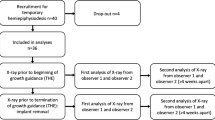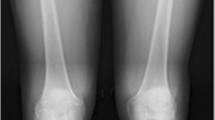Abstract
Purpose
Lower extremity alignment is an important consideration prior to cartilage surgery and/or osteotomy about the knee. This is measured on full length standing hip to ankle radiographs, which has traditionally been done using hard copy radiographs. However, the advent of PACS (Picture Archiving and Communication Systems) has allowed these measurements to be done on computer based digital radiographs. The objectives of this study were to evaluate the intra- and inter-observer reliability of lower limb alignment measures manually obtained from hard copy radiographs versus using the Philips Easy Vision system, and to assess the subjective ease of use for the two methods.
Methods
Forty-two patients who underwent surgery and who had a standing hip to ankle radiograph on file were identified. Four raters, including two radiologists and two orthopaedic surgeons, measured each hard copy radiograph and computer image on two separate occasions. Three measurements were recorded for each hard copy radiograph and computer image—width of tibial plateau, the distance from the medial aspect of the tibial plateau to the weight-bearing line, and the mechanical axis.
Results
All correlations for this study were high. For tibial plateau data, the hard copy radiographs compared to PACS demonstrated intra-class correlation coefficients (ICC) ranging from 0.93 to 0.99 for inter-rater reliability for the four raters. The ICC for intra-rater reliability for hard copies ranged from 0.90 to 0.99 and for PACS from 0.94 to 0.99. The inter-rater data comparing raters ranged from 0.87 to 0.98 for hard copy radiographs and from 0.98 to 0.99 for PACS. For mechanical axis data, the ICC for hard copy radiograph compared to PACS ranged from 0.93 to 0.97 for the intra-rater reliability for the four raters. The intra-rater reliability for mechanical axis data on hard copy radiograph ranged from an ICC of 0.86 to 0.96, and for PACS the ICC ranged from 0.93 to 0.99. The inter-observer data for hard copy radiographs using the mechanical axis ranged from 0.88 to 0.94 and for PACS ranged from 0.93 to 0.97. The physicians rated PACS as statistically significantly easier to use when compared to hard copy (P = 0.03).
Conclusion
Evaluation of lower extremity alignment using two techniques prior to knee surgery was found to have higher inter- and intra-observer reliability using PACS software. PACS is now used prior to cartilage surgery and/or osteotomy to measure both alignment and the location of the weight bearing line on the tibial plateau both before and after surgery.
Level of evidence
Diagnostic study, Level I.





Similar content being viewed by others
References
Chao EYS, Sim FH (1995) Computer-aided preoperative planning in knee osteotomy. Iowa Orthop J 15:4–18
Hankemeier S, Gosling T, Richter M, Hufner T, Hochhausen C, Krettek C (2006) Computer-assisted analysis of lower limb geometry: higher intraobserver reliability compared to conventional method. Comput Aided Surg 11:81–86
Hsu RW, Himeno S, Coventry MB, Chao EY (1990) Normal axial alignment of the lower extremity and load-bearing distribution at the knee. Clin Orthop Relat Res 255:215–227
Marx RG, Jones EC, Allen AA, Altchek DW, O’Brien SJ, Rodeo SA, Williams RJ, Warren RF, Wickiewicz TL (2001) Knee outcome scales for athletic patients. J Bone Joint Surg Am 83:1459–1469
Prakash U, Wigderowitz CA, McGurty DW, Rowley DI (2001) Computerised measurement of tibiofemoral alignment. J Bone Joint Surg Am 83:819–824
Sailer J, Scharitzer M, Peloschek P, Giurea A, Imhof H, Grampp S (2005) Quantification of axial alignment of the lower extremity on conventional and digital total leg radiographs. Eur Radiol 15:170–173
Sled EA, Sheehy LM, Felson DT, Costigan PA, Lam M, Derek T, Cooke V (2011) Reliability of lower limb alignment measures using an established landmark-based method with a customized computer software program. Rheumatol Int 31:71–77
Specogna AV, Birmingham TB, DaSilva JJ, Milner JS, Kerr J, Hunt MA, Jones IC, Jenkyn TR, Fowler PJ, Giffin JR (2004) Reliability of lower limb frontal plane alignment measurements using plain radiographs and digitized images. J Knee Surg 17:203–210
Takahashi T, Yamanaka N, Komatsu M, Ogawa Y, Yoshida S, Yamamoto H (2003) A new computer-assisted method for measuring the tibio-femoral angle in patients with osteoarthritis of the knee. Osteoarthr Cartil 12:256–259
Acknowledgments
The authors acknowledge the contributions of John Cavanaugh, Li Foong Foo, Jo Hannafin, Hollis Potter, Scott Rodeo, Russell Warren, Thomas Wickiewicz and Riley Williams to the development of this study.
Author information
Authors and Affiliations
Corresponding author
Rights and permissions
About this article
Cite this article
Marx, R.G., Grimm, P., Lillemoe, K.A. et al. Reliability of lower extremity alignment measurement using radiographs and PACS. Knee Surg Sports Traumatol Arthrosc 19, 1693–1698 (2011). https://doi.org/10.1007/s00167-011-1467-3
Received:
Accepted:
Published:
Issue Date:
DOI: https://doi.org/10.1007/s00167-011-1467-3




